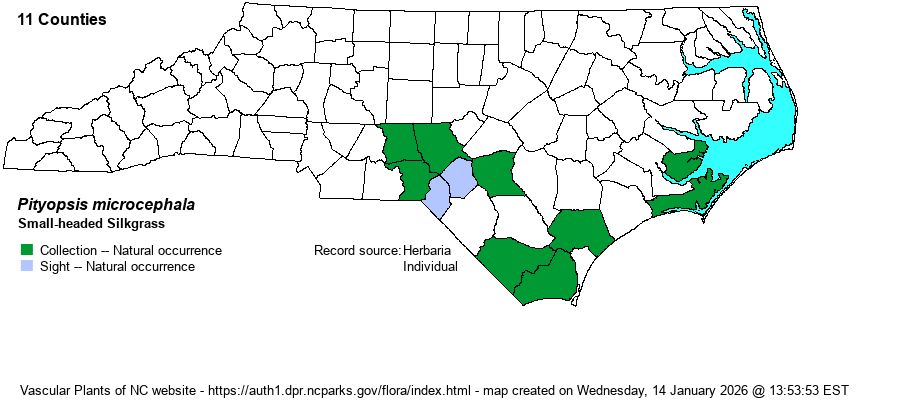| Author | (Small) Small | |
| Distribution | Sandhills and southern outer Coastal Plain, north to Pamlico County. The gap shown on the map is apparently real, but may reflect a general loss of Longleaf Pine-Wiregrass habitats and/or recurring fire from the south-central Coastal Plain.
NC to southern FL, eastern TX, southeastern OK, and southern AR. Reported from southeastern VA, but not mapped there by FNA. | |
| Abundance | Uncommon over its southern Coastal Plain range (including the Sandhills), but it can be locally common. The NCNHP placed this species on its Watch List (W7) in late 2022. | |
| Habitat | Moist Longleaf Pine-Wiregrass savannas, flatwoods, and ecotones of blackwater streamheads; also found in dry uplands associated with pine stands. | |
| Phenology | Flowering and fruiting July-October. | |
| Identification | The genus Pityopsis has been split from Chrysopsis (the golden-asters) and from Heterotheca (camphorweeds) by the silky, silvery, appressed hairs on leaves and stems. Small-headed Silkgrass grows 1-1.5 feet tall, with slender basal leaves and stem leaves that become greatly reduced upwards. Due to its lack of stalked glands on the upper stems and inflorescence branches, it has been placed within the graminifolia group; however, in the field its slender leaves and small heads more closely resemble those of Pineland Silkgrass (P. aspera). From the latter it differs in lacking stalked glands (vs. abundant). According to FNA, it has narrower leaves than Pineland Silkgrass (2-5 mm wide vs. 5-10 mm wide), but this character needs to be verified. | |
| Taxonomic Comments | Formerly treated as P. graminifolia var. tenuifolia. Needless to say, identification of the handful of Pityopsis species in the state is very difficult, not helped by the challenging taxonomy and shifting of names and taxa by the experts.
In the understanding of the genus Pityopsis, great strides were made in the monograph by Semple and Bowers (1985, with keys, drawings and maps). Very recently, Bridges and Orzell (2018) revised some of the Florida taxa, based on examination of type specimens and lengthy field work (includes keys, maps). Finally, Nesom (2019) produced a synopsis of the genus (with full synonymy, keys and maps). Note that the taxonomic concepts of these authors, Weakley (2020, 2022), and us do not always agree; therefore, readers are encouraged to get familiar with these works and also get to know well your local plants. | |
| Other Common Name(s) | None | |
| State Rank | S2S3 | |
| Global Rank | G5T5? [G5?] | |
| State Status | W7 | |
| US Status | | |
| USACE-agcp | | |
| USACE-emp | | |

